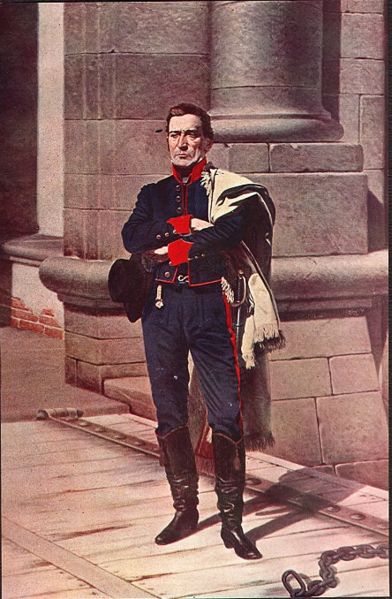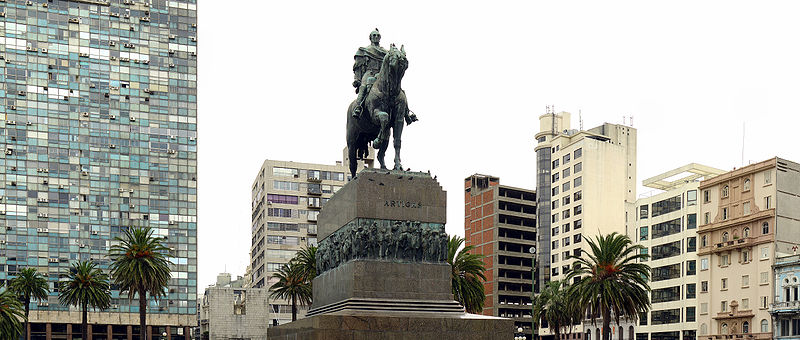<Back to Index>
- Mathematician Blaise Pascal, 1623
- Painter Thomas Sully, 1783
- Father of Uruguayan Independence José Gervasio Artigas Arnal, 1764


José Gervasio Artigas Arnal (June 19, 1764 – September 23, 1850) is a national hero of Uruguay, sometimes called "the father of Uruguayan independence".
Born in Montevideo to a wealthy family, at age 12 he moved to the countryside and worked on his family's farms. He excelled at marksmanship and riding, and tried his hand at smuggling from Portuguese-controlled Brazil.
At age 33, he took advantage of an amnesty for those who had committed non-violent crimes, and entered the Corps of Blandengues to protect the border with Brazil. From 1806 to 1807, he participated in the Spanish resistance to the British invasions of the Río de la Plata. He was part of the force which, under Santiago de Liniers, Montevideo contributed to the liberation ("Reconquista") of Buenos Aires from William Beresford, 1st Viscount Beresford's occupation in 1806, and also to the Battle of Montevideo. Following the Spanish defeat at Montevideo, he was captured. He was spared being shipped to Britain as a prisoner of war, having been wounded in the battle.
In 1810, Spain moved the headquarters for the Viceroyalty of the Río de la Plata to Montevideo after the May Revolution forced them to abandon Buenos Aires. On 15 February 1811, Artigas left the Corps of Blandengues and went to Buenos Aires to offer his military services in the fight for independence in the Eastern Bank (present-day Uruguay). In early April, he returned to the Eastern Bank with approximately 180 men provided by the Government of Buenos Aires; on April 11, he issued the Mercedes Proclamation, assumed control of the revolution and on May 18 defeated the Spanish in the Battle of Las Piedras. He set siege to Montevideo and was proclaimed First Chief of the "Orientals" (the name of Uruguay being originally Banda Oriental del Uruguay (Eastern Bank of Uruguay) and later Provincia Oriental del Uruguay (Oriental Province of Uruguay)); Uruguayans thus refer to themselves as Orientales.
In 1814, he organized the Liga de los Pueblos Libres (League of the Free Peoples), of which he was declared Protector. In the following year, he liberated Montevideo from the control of the "Unitarians" from Buenos Aires. In 1815, he attended the Proto-congress of the Independence of Argentina, held in Arrollo de la China (today known as Concepción del Uruguay). It was at this congress that the provinces of the Oriental Province (today the country of Uruguay), Córdoba, Corrientes, Entre Ríos, Misiones and Santa Fe declared themselves independent from Spain and formed the Liga Federal ("Federal League"). The Liga Federal invited other provinces of the former Viceroyalty of Rio de la Plata to join them under a federal system. In this congress, Artigas ratified the use of the flag created by Manuel Belgrano (which would later become the flag of the Argentine Republic), but added a diagonal festoon in red, the color of federalism in Argentina at that time. The continued growth of influence and prestige of the Federal League frightened the governments in Buenos Aires (because of its federalism) and Portugal (because of its republicanism), and in August 1816, Portugal invaded the Eastern Province (with tacit complicity from Buenos Aires), with the intention of destroying Artigas and his revolution.
The Portuguese forces, led by Carlos Frederico Lecor, captured Artigas and his deputies and occupied Montevideo on 20 January 1817, but the struggle continued for three years in the countryside. Infuriated by Buenos Aires's passivity, Artigas declared war on Buenos Aires while he was losing to the Portuguese. His subordinates, members of the Federal League -- Francisco Ramírez, governor of Entre Ríos, and Estanislao López, governor of Santa Fe -- managed to defeat the centralism of Buenos Aires. But hope for a new nation was short-lived; both commanders entered agreements with Buenos Aires that went against the principles of Artigas. They rebelled against him and left him to be crushed by the Portuguese. Without resources and men, Artigas withdrew to Paraguay in September 1820. In Paraguay, Dr. Francia, the dictator, banished him to Candelaria. He then disappeared from the political life of the region.
After a long exile, he died in Paraguay in 1850, age 86. It is said that Artigas, feeling near death, asked for a horse and died in the saddle, as a gaucho. His remains were buried and then reïntered at the Panteón Nacional in 1855. On the 19th of June, 1977, his remains were transferred to the Artigas Mausoleum in the center of the Plaza Independencia.
Artigas admired the United States of America and was said to always carry a copy of the United States Constitution with him. He wanted the United Provinces of the River Plate government
to be based on the same federalist ideas as the USA. These ideals went
against what the Buenos Aires government of the time wanted (a
centralised state; some even supported the idea of putting a European
monarch in charge of the newly independent lands), but he managed to
gain the support of some other provinces. Because of this, the Buenos
Aires government supported the Portuguese invasion of the Eastern Bank.
